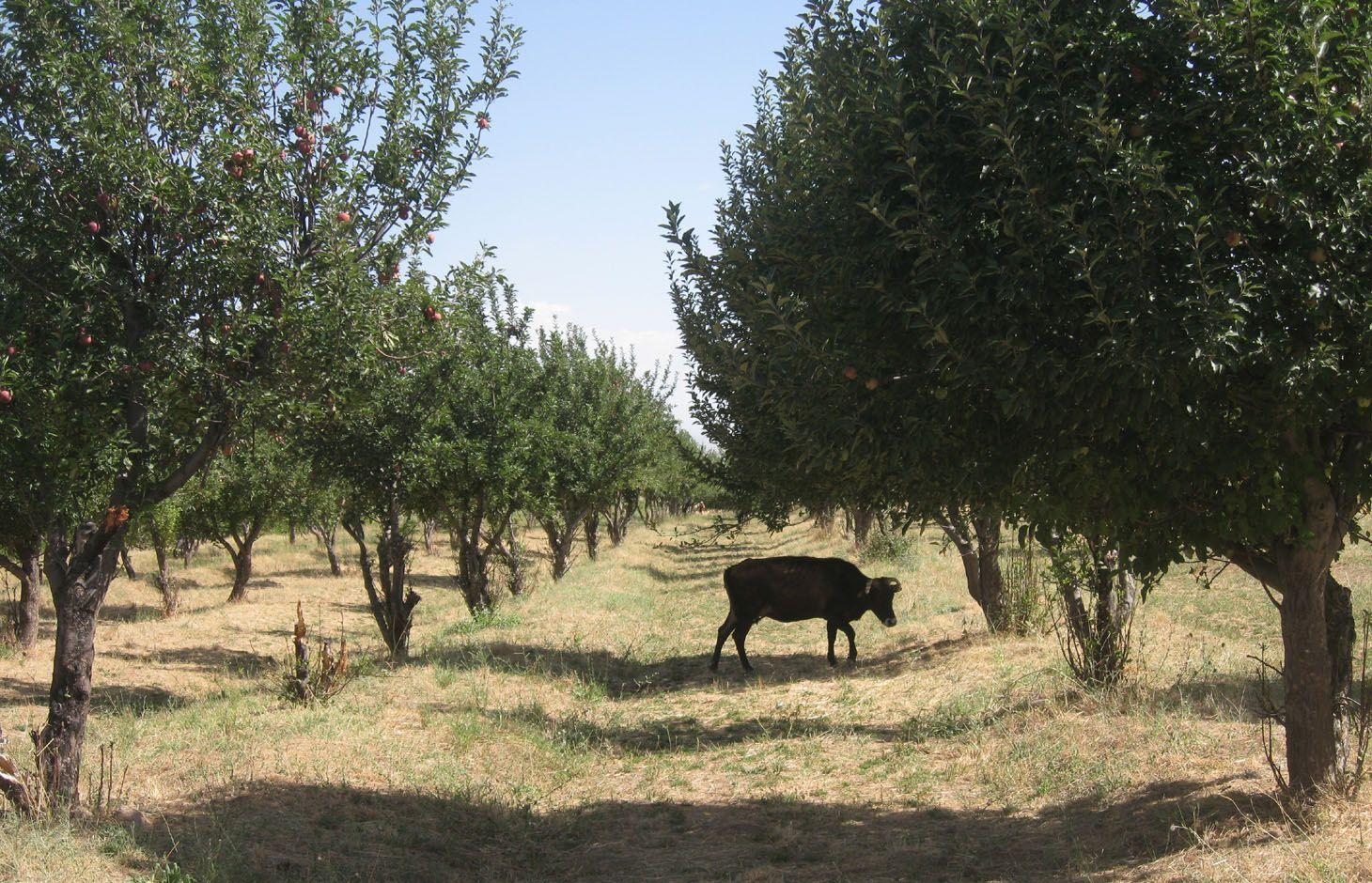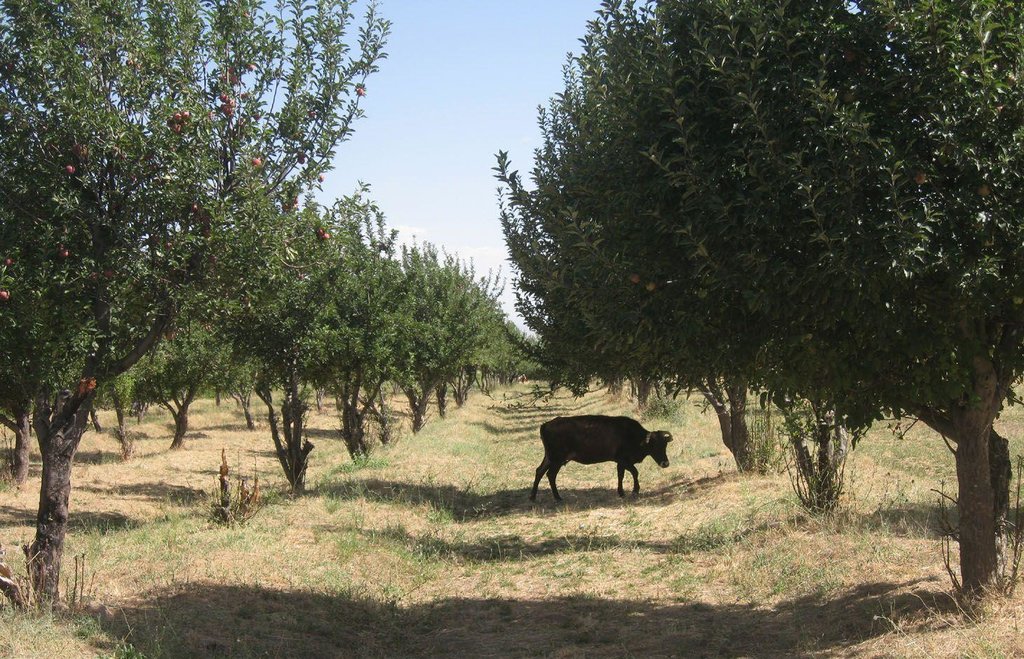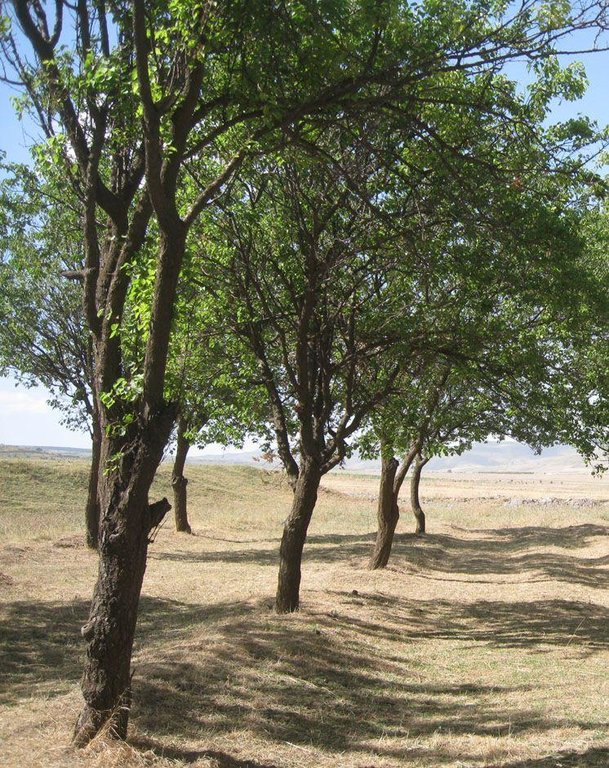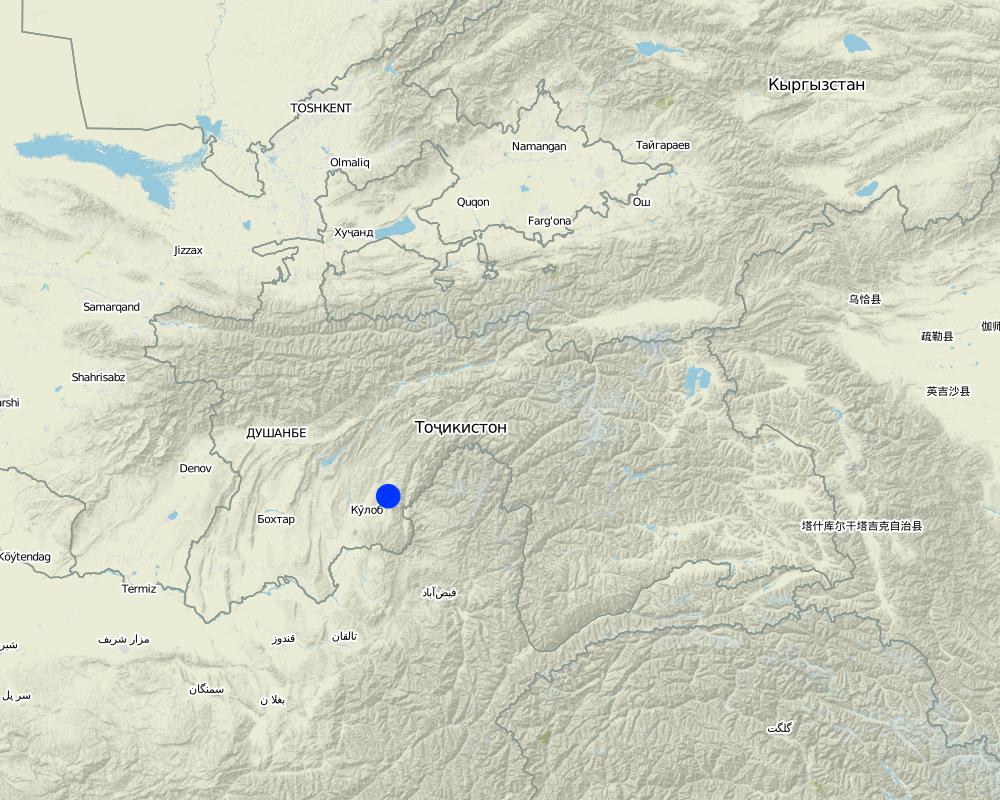Current agroforesty of an apple orchard with wheat cropping [Tadjikistan]
- Création :
- Mise à jour :
- Compilateur : Malgorzata Conder
- Rédacteur : –
- Examinateurs : Fabian Ottiger, Alexandra Gavilano
technologies_1172 - Tadjikistan
Voir les sections
Développer tout Réduire tout1. Informations générales
1.2 Coordonnées des personnes-ressources et des institutions impliquées dans l'évaluation et la documentation de la Technologie
Nom du ou des institutions qui ont facilité la documentation/ l'évaluation de la Technologie (si pertinent)
CDE Centre for Development and Environment (CDE Centre for Development and Environment) - Suisse1.3 Conditions relatives à l'utilisation par WOCAT des données documentées
Le compilateur et la(les) personne(s) ressource(s) acceptent les conditions relatives à l'utilisation par WOCAT des données documentées:
Oui
2. Description de la Technologie de GDT
2.1 Courte description de la Technologie
Définition de la Technologie:
Agroforestry of an old apple orchard with wheat cropping
2.2 Description détaillée de la Technologie
Description:
The farmer grows red, yellow and white apples in his orchard of 3.75 ha. Wheat is growing in the slightly pronounced terraces and recently some vines were planted this year. The rain fed orchard lies in the low part of the middle zone and has a slight slope. The absence of control and fence results in broken branches and trampled parts in the plot. The farmer is sharing the property with his four brothers, who inherited the property from their father in 1993 or 1994. The orchard was established during Soviet time in 1988. The government paid for the material and the farmer’s family did the labour. The government paid them for that input by crop yield. In addition to the orchard the farmer sewed wheat between the rows several years ago which adds up to a hectare of wheat crop in total. In the current year (2012), the workload and the yield have been very small. As there was heavy rainfall in spring, the farmer did not see the need to loose soil around the trees. The already old fruit trees gave low yield and, because of a hale storm, apples were destroyed.
Purpose of the Technology: Initially the government planned to manage land and make it more profitable by establishing orchards. Due to that intention the farmer’s family had work, subsistent crop and cash crops. Today the main source of income is the remittances from the sons who work in Russia. The farmer works part time as a taxi driver. The orchard lost its importance of main income.
Establishment / maintenance activities and inputs: At the time of the establishment of the fruit trees, the Soviet government paid for the seedlings and tractor fuel. Labour was done by the farmer, his brothers and their parents. The whole family worked for two years to build the orchard because they only had the possibility to work in the evenings and on weekends. Nowadays it is still a part time job for the farmer. Maintenance activities consist of ploughing, occasional soil loosening around the trees, pruning and harvesting apples and wheat. The wheat is cut by hand, which is very hard work. Because of heavy rainfalls last spring no soil was loosened. There is nobody to protect the orchard from grazing livestock.
Natural / human environment: The orchard lies on a foothill in the middle zone, close to the settlements of the valley. The apples trees are growing in rows on small terraces built by ploughing for years. Down- and upwards there are also orchards growing, all delimited laterally by the riverbed and a road. On one side of the plot a gully is developing rapidly. All of the neighbouring orchards seem to have a lack of maintenance and control. The orchards lying above but not far away from the settlements are accessible by car and tractor.
2.3 Photos de la Technologie
2.5 Pays/ région/ lieux où la Technologie a été appliquée et qui sont couverts par cette évaluation
Pays:
Tadjikistan
Région/ Etat/ Province:
Khatlon, Tajikistan
Autres spécifications du lieu:
Muminabad
Spécifiez la diffusion de la Technologie:
- répartie uniformément sur une zone
S'il n'existe pas d'informations exactes sur la superficie, indiquez les limites approximatives de la zone couverte:
- < 0,1 km2 (10 ha)
Commentaires:
Total area covered by the SLM Technology is 3.75 km2.
Property belongs to five sons
Map
×2.6 Date de mise en œuvre de la Technologie
Si l'année précise est inconnue, indiquez la date approximative: :
- il y a entre 10-50 ans
2.7 Introduction de la Technologie
Spécifiez comment la Technologie a été introduite: :
- par le biais de projets/ d'interventions extérieures
Commentaires (type de projet, etc.) :
in 1988 orchard was established, since 1993 or 1994 the orchard belongs to the farmer and his four brothers
3. Classification de la Technologie de GDT
3.1 Principal(aux) objectif(s) de la Technologie
- améliorer la production
- réduire, prévenir, restaurer les terres dégradées
3.2 Type(s) actuel(s) d'utilisation des terres, là où la Technologie est appliquée
Les divers types d'utilisation des terres au sein du même unité de terrain: :
Oui
Précisez l'utilisation mixte des terres (cultures/ pâturages/ arbres):
- Agroforesterie

Terres cultivées
- Cultures annuelles
- Plantations d’arbres ou de buissons
Cultures annuelles - Précisez les cultures:
- céréales - blé de printemps
Plantations d'arbres et d'arbustes - Précisez les cultures:
- fruits, autres
- fruits à pépins (pommes, poires, coings, etc.)
Nombre de période de croissance par an: :
- 1
Précisez:
Longest growing period in days: 180 Longest growing period from month to month: March to September

Pâturages

Forêts/ bois
Commentaires:
Major land use problems (compiler’s opinion): Low soil nutrients and moisture
A lot of bare, compacted and trampled soil which impedes a high infiltration rate
Not sufficiently maintained orchard, incorrectly prouned fruit trees
Deep rill through the middle of the plot
Major land use problems (land users’ perception): Soil is leached out
Fruit trees are old and hence don't give a high yield
Water is only seasonally available
Low infiltration
Livestock is grazing on crop residues
3.4 Approvisionnement en eau
Approvisionnement en eau des terres sur lesquelles est appliquée la Technologie:
- pluvial
3.5 Groupe de GDT auquel appartient la Technologie
- agroforesterie
3.6 Mesures de GDT constituant la Technologie

pratiques agronomiques
- A1: Couverture végétale/ du sol

pratiques végétales
- V1: Couverture d’arbres et d’arbustes
Commentaires:
Type of agronomic measures: mixed cropping / intercropping, contour tillage
3.7 Principaux types de dégradation des terres traités par la Technologie

érosion hydrique des sols
- Wg: ravinement/ érosion en ravines
- Wo: effets hors-site de la dégradation

dégradation chimique des sols
- Cn: baisse de la fertilité des sols et réduction du niveau de matière organique (non causée par l’érosion)

dégradation physique des sols
- Pc: compaction

dégradation biologique
- Bc: réduction de la couverture végétale
Commentaires:
Main type of degradation addressed: Pc: compaction, Bc: reduction of vegetation cover
Secondary types of degradation addressed: Wg: gully erosion / gullying, Wo: offsite degradation effects, Cn: fertility decline and reduced organic matter content
Main causes of degradation: soil management, crop management (annual, perennial, tree/shrub)
Secondary causes of degradation: overgrazing, Heavy / extreme rainfall (intensity/amounts) (low infiltration rate and heava rainfalls cause rill formation)
4. Spécifications techniques, activités, intrants et coûts de mise en œuvre
4.1 Dessin technique de la Technologie
Spécifications techniques (associées au dessin technique):
The rows with the apple trees are not contour lined, reason why the plot counts 11 rows from one and 13 rows from the other side. The fruit trees grow with a distance of 6 metres to each other. Up to 30 trees were in a row, but due to drying or cutting out (shown in the drawing as "no trees") there are currently some 20 to 25 trees per row in average. Wheat is growing between the rows, mechanical plowing built some terrace-like relief as seen in the profile and sequency "A". A rill dominates the orchard where run off is drained.
Location: Chukurak watershed. Muminabad, Khatlon, Tajikistan
Technical knowledge required for field staff / advisors: high
Technical knowledge required for land users: high
Mixed cropping / intercropping
Material/ species: wheat intercropped in an orchard
Auteur:
Conder Malgorzata
4.2 Informations générales sur le calcul des intrants et des coûts
autre/ monnaie nationale (précisez):
Somoni
Indiquez le taux de change des USD en devise locale, le cas échéant (p.ex. 1 USD = 79.9 réal brésilien): 1 USD = :
4,83
Indiquez le coût salarial moyen de la main d'œuvre par jour:
12.40
4.3 Activités de mise en place/ d'établissement
| Activité | Calendrier des activités (saisonnier) | |
|---|---|---|
| 1. | Buying, transporting and planting trees (5 TJS and 20 min for plantin per tree) | once, spring, in 1988 |
4.4 Coûts et intrants nécessaires à la mise en place
| Spécifiez les intrants | Unité | Quantité | Coûts par unité | Coût total par intrant | % du coût supporté par les exploitants des terres | |
|---|---|---|---|---|---|---|
| Main d'œuvre | Buying, transporting and planting tree | person days | 50,0 | 12,422 | 621,1 | 100,0 |
| Equipements | Machine use | Days | 1,0 | 16,6 | 16,6 | |
| Matériel végétal | Seedlings | Seedlings | 1200,0 | 1,03516666 | 1242,2 | |
| Coût total de mise en place de la Technologie | 1879,9 | |||||
| Coût total de mise en place de la Technologie en dollars américains (USD) | 389,21 | |||||
Commentaires:
Duration of establishment phase: 24 month(s)
4.5 Activités d'entretien/ récurrentes
| Activité | Calendrier/ fréquence | |
|---|---|---|
| 1. | Plowing, 6 hours, 1 person | spring since 1988 |
| 2. | Sowing, 3 hours, 1 person | once a year |
| 3. | Cutting wheat manually by, 1 week (7h/day) 6 pers | once a year, autumn |
| 4. | Soil loosening (it was not done in 2012) | once a year, spring |
| 5. | Pruning (it was not done in 2012) | every tree once in 3 years |
| 6. | Harvesting apples (1000) | once a year, autumn |
4.6 Coûts et intrants nécessaires aux activités d'entretien/ récurrentes (par an)
| Spécifiez les intrants | Unité | Quantité | Coûts par unité | Coût total par intrant | % du coût supporté par les exploitants des terres | |
|---|---|---|---|---|---|---|
| Main d'œuvre | Plowing | Person days | 0,75 | 12,4 | 9,3 | 100,0 |
| Main d'œuvre | Sowing | Person days | 0,375 | 12,4 | 4,65 | 100,0 |
| Main d'œuvre | Cutting wheat manually | Person days | 36,75 | 12,4 | 455,7 | 100,0 |
| Main d'œuvre | Soil loosening | Trees | 1000,0 | 0,1941 | 194,1 | 100,0 |
| Equipements | Petrol | liters | 40,0 | 1,1375 | 45,5 | 100,0 |
| Equipements | Machine use | Hours | 3,0 | 6,9 | 20,7 | 100,0 |
| Matériel végétal | Seeds | Kg | 200,0 | 0,414 | 82,8 | 100,0 |
| Autre | Pruning | Trees | 400,0 | 0,711 | 284,4 | 100,0 |
| Autre | Harvesting apples | Apples | 1000,0 | 0,7453 | 745,3 | 100,0 |
| Coût total d'entretien de la Technologie | 1842,45 | |||||
| Coût total d'entretien de la Technologie en dollars américains (USD) | 381,46 | |||||
Commentaires:
Establishment phase: Seedlings and transport were paid by the government, planting was done by the farmer and his family. Labor (recurrent activity(3))for apple harvesting calculated according to T_TAJ013.
4.7 Facteurs les plus importants affectant les coûts
Décrivez les facteurs les plus importants affectant les coûts :
Labour affects the cost the most, secondly the seedlings (which were subsidised).
5. Environnement naturel et humain
5.1 Climat
Précipitations annuelles
- < 250 mm
- 251-500 mm
- 501-750 mm
- 751-1000 mm
- 1001-1500 mm
- 1501-2000 mm
- 2001-3000 mm
- 3001-4000 mm
- > 4000 mm
Spécifications/ commentaires sur les précipitations:
Totally 800 mm: 700mm in winter-spring, July-Sept dry season
Zone agro-climatique
- subhumide
Thermal climate class: temperate, LPG from end of March until September
5.2 Topographie
Pentes moyennes:
- plat (0-2 %)
- faible (3-5%)
- modéré (6-10%)
- onduleux (11-15%)
- vallonné (16-30%)
- raide (31-60%)
- très raide (>60%)
Reliefs:
- plateaux/ plaines
- crêtes
- flancs/ pentes de montagne
- flancs/ pentes de colline
- piémonts/ glacis (bas de pente)
- fonds de vallée/bas-fonds
Zones altitudinales:
- 0-100 m
- 101-500 m
- 501-1000 m
- 1001-1500 m
- 1501-2000 m
- 2001-2500 m
- 2501-3000 m
- 3001-4000 m
- > 4000 m
5.3 Sols
Profondeur moyenne du sol:
- très superficiel (0-20 cm)
- superficiel (21-50 cm)
- modérément profond (51-80 cm)
- profond (81-120 cm)
- très profond (>120 cm)
Texture du sol (de la couche arable):
- moyen (limoneux)
- fin/ lourd (argile)
Si disponible, joignez une description complète du sol ou précisez les informations disponibles, par ex., type de sol, pH/ acidité du sol, capacité d'échange cationique, azote, salinité, etc.
Soil fertility: Low
Soil drainage/infiltration: Poor
Soil water storage capacity: Low
5.4 Disponibilité et qualité de l'eau
Disponibilité de l’eau de surface:
faible/ absente
Qualité de l’eau (non traitée):
uniquement pour usage agricole (irrigation)
5.5 Biodiversité
Diversité des espèces:
- faible
5.6 Caractéristiques des exploitants des terres appliquant la Technologie
Orientation du système de production:
- subsistance (auto-approvisionnement)
Revenus hors exploitation:
- > 50% de tous les revenus
Niveau relatif de richesse:
- moyen
Individus ou groupes:
- individu/ ménage
Niveau de mécanisation:
- travail manuel
- mécanisé/ motorisé
Genre:
- hommes
Indiquez toute autre caractéristique pertinente des exploitants des terres:
Land users applying the Technology are mainly common / average land users
Population density: 100-200 persons/km2
Annual population growth: 1% - 2%
Off-farm income specification: The farmer is working mainly as taxi driver
Level of mechanization: Manual labour (ranked 1, sowing, harvesting, soil losening) and mechanised (ranked 2, plowing)
5.7 Superficie moyenne des terres utilisées par les exploitants des terres appliquant la Technologie
- < 0,5 ha
- 0,5-1 ha
- 1-2 ha
- 2-5 ha
- 5-15 ha
- 15-50 ha
- 50-100 ha
- 100-500 ha
- 500-1 000 ha
- 1 000-10 000 ha
- > 10 000 ha
Cette superficie est-elle considérée comme de petite, moyenne ou grande dimension (en se référant au contexte local)?
- petite dimension
Commentaires:
2.06 ha (household 7.7 members)
5.8 Propriété foncière, droits d’utilisation des terres et de l'eau
Propriété foncière:
- individu, avec titre de propriété
Droits d’utilisation des terres:
- loué
Droits d’utilisation de l’eau:
- communautaire (organisé)
5.9 Accès aux services et aux infrastructures
santé:
- pauvre
- modéré
- bonne
éducation:
- pauvre
- modéré
- bonne
assistance technique:
- pauvre
- modéré
- bonne
emploi (par ex. hors exploitation):
- pauvre
- modéré
- bonne
marchés:
- pauvre
- modéré
- bonne
énergie:
- pauvre
- modéré
- bonne
routes et transports:
- pauvre
- modéré
- bonne
eau potable et assainissement:
- pauvre
- modéré
- bonne
services financiers:
- pauvre
- modéré
- bonne
6. Impacts et conclusions
6.1 Impacts sur site que la Technologie a montrés
Impacts socio-économiques
Production
production agricole
Commentaires/ spécifiez:
middle-term increase however possibility of lower harvest due to lack of maintenance
Revenus et coûts
revenus agricoles
Commentaires/ spécifiez:
not on short-term, low harvest if maintenance is done poorly.
charge de travail
Commentaires/ spécifiez:
Less mainetnance work
Impacts socioculturels
sécurité alimentaire/ autosuffisance
Commentaires/ spécifiez:
low harvest, but it is not the only source of income
Impacts écologiques
Cycle de l'eau/ ruissellement
quantité d'eau
Commentaires/ spécifiez:
Difficult to compare established orchard with szenario without orchard
ruissellement de surface
Sols
humidité du sol
couverture du sol
encroûtement/ battance du sol
compaction du sol
matière organique du sol/ au dessous du sol C
Réduction des risques de catastrophe et des risques climatiques
vitesse du vent
6.2 Impacts hors site que la Technologie a montrés
inondations en aval
capacité tampon/de filtration
6.3 Exposition et sensibilité de la Technologie aux changements progressifs et aux évènements extrêmes/catastrophes liés au climat (telles que perçues par les exploitants des terres)
Changements climatiques progressifs
Changements climatiques progressifs
| Saison | Augmentation ou diminution | Comment la Technologie fait-elle face à cela? | |
|---|---|---|---|
| températures annuelles | augmente | pas bien |
Extrêmes climatiques (catastrophes)
Catastrophes météorologiques
| Comment la Technologie fait-elle face à cela? | |
|---|---|
| pluie torrentielle locale | pas bien |
| tempête de vent locale | pas connu |
Catastrophes climatiques
| Comment la Technologie fait-elle face à cela? | |
|---|---|
| sécheresse | pas bien |
Catastrophes hydrologiques
| Comment la Technologie fait-elle face à cela? | |
|---|---|
| inondation générale (rivière) | pas bien |
Autres conséquences liées au climat
Autres conséquences liées au climat
| Comment la Technologie fait-elle face à cela? | |
|---|---|
| réduction de la période de croissance | pas bien |
6.7 Points forts/ avantages/ possibilités de la Technologie
| Points forts/ avantages/ possibilités du point de vue de l'exploitant des terres |
|---|
|
Increase of productivity of the land by establishing an orchard. How can they be sustained / enhanced? Give more power and knowledge to farmers to raise responsability for the crops. |
| Points forts/ avantages/ possibilités du point de vue du compilateur ou d'une autre personne ressource clé |
|---|
|
Land management is right if maintenance and technical assistence are warranted. How can they be sustained / enhanced? Support of establishment and recurrent activities is important. |
6.8 Faiblesses/ inconvénients/ risques de la Technologie et moyens de les surmonter
| Faiblesses/ inconvénients/ risques du point de vue de l’exploitant des terres | Comment peuvent-ils être surmontés? |
|---|---|
| Old trees. | Plant new ones. |
| Faiblesses/ inconvénients/ risques du point de vue du compilateur ou d'une autre personne ressource clé | Comment peuvent-ils être surmontés? |
|---|---|
| Orchard is not well maintained (sporadical soil loosening, pruning, control). | Knowledge transfer with e.g. demonstration of well maintained orchards and round tables to share farming experiences. |
| Support shoulb not only focus on the establishment phase (by provdiding funds) but also in a long-term providing cultivation knowledge. |
7. Références et liens
7.1 Méthodes/ sources d'information
Liens et modules
Développer tout Réduire toutLiens
Aucun lien
Modules
Aucun module trouvé





